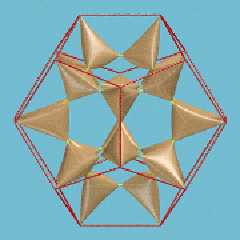|
 |
Doctor John schreef:
> Thought I'd share this with you all.
> IMNSHO it's the best rendering of (part of) the Barth Decic that I've seen
> for a while.
>
> For the record:
> #declare a=1.0
> #declare GM=(sqr(5)+1)/2
> #declare GM4=pow(GM, 4)
>
> function(x,y,z,a) {
> 8*(pow(x, 2)-GM4*pow(y, 2))*(pow(y, 2)-GM4*pow(z, 2))*(pow(z, 2)-
> GM4*pow(x, 2))*(pow(x, 4)+pow(y, 4)+pow(z, 4)-2*pow(x, 2)*
> pow(y, 2)-2*pow(x, 2)*pow(z, 2)-2*pow(y, 2)*pow(z, 2))+(3+5*GM)
> *pow((pow(x, 2)+pow(y, 2)+pow(z, 2)-pow(a, 2)),2)*pow((pow(x, 2)
> +pow(y, 2)+pow(z, 2)-(2-GM)*pow(a, 2)),2)*pow(a, 2)
> }
>
> max_gradient 25060
> contained_by{sphere {0, 1.9}}
>
>
> ...and the texture:
> texture {
> pigment {
> aoi <3, 1, 3>
> color_map {
> [0 color rgb <1.0,0.4,0.25>]
> [0.8 color rgb <0.15,0.25,0.9>]
> }
> }
> finish {
> ambient 0
> diffuse 0.7
> specular 0.16
> }
> }
>
> Must be rendered using Megapov >=1.1
>
> John
Barth's SEXTIC is a surface with 65 double points. It's interesting to
know that 20 of these double points are the vertices of a regular
dodecahedron and 30 other double points are the midpoints of the edges
of another regular dodecahedron. Both dodecahedra have the same center
and the edges are parallel. I have illustrated this property in a small
animated gif.
I used the "poly" representation of the surface and not "function".
More images can be seen here:
http://cage.ugent.be/~hs
Post a reply to this message
Attachments:
Download 'animbarth04d.gif' (443 KB)
Preview of image 'animbarth04d.gif'

|
 |




![]()